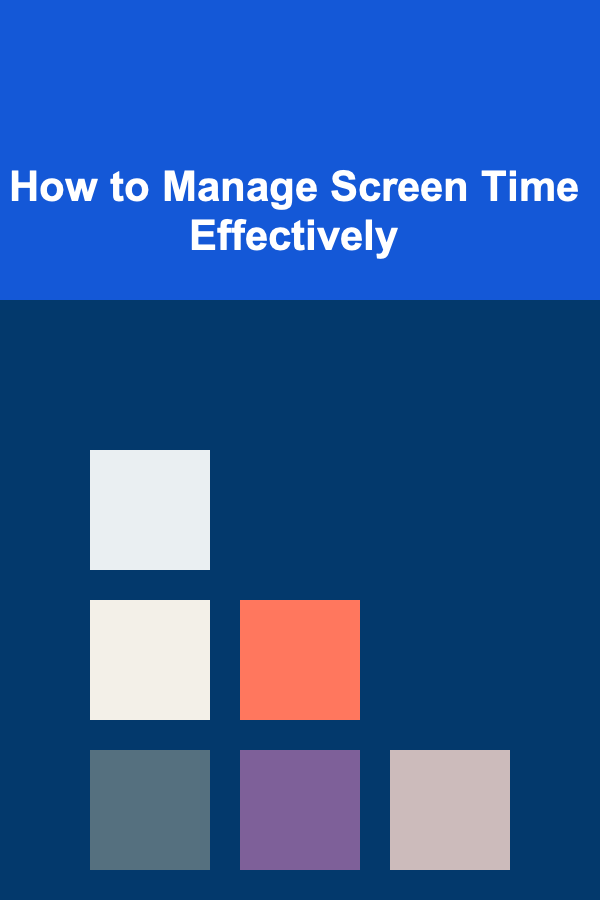
How to Manage Screen Time Effectively
ebook include PDF & Audio bundle (Micro Guide)
$12.99$10.99
Limited Time Offer! Order within the next:

In today's digital age, screen time is an inevitable part of our daily lives. Whether it's for work, entertainment, or staying connected with friends and family, screens have become essential tools in most of our daily routines. However, excessive screen time can have significant effects on our physical and mental health, productivity, and overall well-being. The challenge, then, is to find a balance -- to use screens effectively without allowing them to dominate our time.
This article explores how to manage screen time effectively, addressing its impact, strategies for reducing excessive use, and how to cultivate healthier screen habits.
The Impact of Excessive Screen Time
Before diving into strategies for managing screen time, it's essential to understand the consequences of excessive screen exposure. While technology brings convenience and connectivity, too much screen time can have serious repercussions.
1. Physical Health Concerns
- Eye Strain and Fatigue : Prolonged use of screens can lead to a condition known as digital eye strain. Symptoms include dryness, blurred vision, headaches, and neck pain. This condition is common among individuals who spend long hours in front of screens, often without taking regular breaks.
- Sleep Disruption: The blue light emitted by screens interferes with the production of melatonin, a hormone that regulates sleep. Late-night screen use, especially on smartphones or computers, can delay sleep onset and reduce sleep quality. Poor sleep can have long-term effects on cognitive function, mood, and general health.
- Sedentary Lifestyle: Excessive screen time often correlates with a sedentary lifestyle. Spending hours in front of a screen typically means limited physical activity, contributing to obesity, cardiovascular diseases, and poor posture. It's crucial to break this cycle with intentional movement throughout the day.
2. Mental and Emotional Effects
- Decreased Attention Span: Constant screen exposure, especially to social media, short-form videos, and multi-tasking, can lead to a reduced attention span. This makes it difficult to focus on tasks that require sustained mental effort, such as reading, studying, or engaging in deep thinking.
- Increased Anxiety and Stress: Constantly checking notifications, social media feeds, or news updates can cause feelings of anxiety and stress. Studies show that people who spend more time on social media tend to experience higher levels of stress, especially when comparing themselves to others or consuming negative content.
- Isolation: While screens allow us to stay connected virtually, they can also lead to isolation. Spending too much time on screens, especially in solitary activities, can reduce face-to-face interactions and social connections, leading to feelings of loneliness and emotional disconnect.
3. Productivity and Work-Life Balance
- Reduced Productivity: The allure of social media, entertainment apps, and notifications can distract individuals from important tasks. It becomes easier to procrastinate or waste time, which diminishes productivity at work or school. Without proper management, screen time can lead to inefficiency and decreased work quality.
- Blurred Boundaries: With the rise of remote work, the line between work and personal life has become blurred. Constant access to email, work-related apps, and meetings can make it difficult to switch off. This lack of clear boundaries between work and rest time often leads to burnout.
Strategies to Manage Screen Time Effectively
Managing screen time effectively requires a combination of awareness, setting clear goals, and implementing practical strategies. Here are some actionable steps to help reduce screen time while ensuring it remains productive and enjoyable.
1. Set Clear Boundaries
To prevent screens from overtaking your life, it's important to set clear boundaries. This involves being mindful of how much time you spend on screens and establishing designated periods where you will not engage with them.
- Set "Screen-Free" Zones: Establish specific areas in your home or workplace where screens are not allowed. For example, keep the bedroom as a "no-screen zone" to encourage better sleep hygiene and promote rest. The dining table is another area where you can foster face-to-face conversations without distractions.
- Designate Screen-Free Times: Create a daily schedule that includes designated periods for screen-free activities. For instance, you might decide not to check your phone for the first hour after waking up or before going to bed. Similarly, take breaks during work hours to engage in physical activities, such as walking or stretching.
2. Use Screen Time Monitoring Tools
Many devices and apps now offer screen time tracking features that can help you become more aware of your screen usage. These tools can provide detailed reports on how much time you spend on different apps and websites.
- Apple's Screen Time: For iOS users, Screen Time allows you to monitor how much time you spend on specific apps. You can set time limits for individual apps, which can help control the temptation to check social media or entertainment apps excessively.
- Android's Digital Wellbeing: Similar to Apple's Screen Time, Android's Digital Wellbeing feature offers insights into your screen usage, including a breakdown of time spent on apps and websites. You can set app timers to limit usage and enable "Focus Mode" to block distractions during work.
- Third-Party Apps : Apps like Forest , Moment , and RescueTime provide additional tracking and limiting features. Forest, for example, encourages users to stay off their phones by growing a virtual tree. If you use your phone, the tree dies, helping you stay focused and engaged in non-screen activities.
3. Prioritize Activities That Don't Involve Screens
One of the most effective ways to manage screen time is by prioritizing non-screen activities that promote physical and mental well-being. These activities can serve as alternatives to time spent in front of a screen and help you maintain a healthier balance.
- Exercise: Physical activity is an excellent way to disconnect from screens and engage your body. Whether it's going for a walk, cycling, practicing yoga, or hitting the gym, exercise promotes both physical health and mental clarity. Consider using a fitness app that helps track your progress without requiring excessive screen time.
- Reading: Reading books, magazines, or newspapers is a great way to take a break from digital content. The act of reading promotes focus and allows you to delve deeper into topics without distractions. If you prefer eBooks, consider setting reading limits to prevent excessive screen exposure.
- Socializing in Person: Spend more time engaging with family and friends face-to-face, whether at home, at a café, or outdoors. In-person conversations help build deeper emotional connections and provide a break from the superficial nature of online interactions.
- Creative Hobbies: Take up hobbies that encourage hands-on engagement, such as drawing, cooking, gardening, or playing an instrument. These activities foster creativity and provide a sense of accomplishment without relying on screens.
4. Implement the Pomodoro Technique
For individuals who use screens for work or study, the Pomodoro Technique can be an effective method for managing screen time while maintaining productivity. This technique involves working in focused intervals (usually 25 minutes), followed by short breaks.
- Work in Short Intervals: During each Pomodoro session, commit to working without distractions. Use a timer to keep track of time. After 25 minutes, take a 5-minute break to rest your eyes and stretch.
- Take Longer Breaks: After completing four Pomodoro sessions, take a longer break (15-30 minutes). This helps prevent burnout and allows your brain to recharge.
This technique can be particularly useful for managing work tasks or study sessions, as it encourages focus and minimizes distractions from social media or other apps.
5. Practice Mindful Consumption of Content
In a world of endless information, it's essential to be mindful of what and how you consume content. Rather than mindlessly scrolling through social media feeds or watching random videos, curate your screen time to focus on content that adds value to your life.
- Set Goals for Screen Time: Define specific goals for your screen time. For instance, decide to spend only 30 minutes a day on social media or limit your TV watching to a set amount each week. By setting clear boundaries, you prevent excessive consumption of mindless content.
- Curate Your Media Consumption: Follow accounts, channels, or blogs that align with your interests and values. Whether it's educational content, inspiring videos, or informative articles, ensure that your screen time contributes positively to your growth and well-being.
- Avoid Negative Content: Avoid content that triggers anxiety, stress, or negative emotions. Instead, focus on content that uplifts and inspires you. Unfollow or mute accounts that do not serve your mental health.
6. Limit Social Media Use
Social media can be one of the biggest time sinks, with endless scrolling and notifications vying for your attention. To manage your screen time effectively, it's essential to limit your social media usage.
- Set Time Limits: Use built-in features on your phone or third-party apps to set time limits on social media apps. Once you reach your limit, the app can be temporarily locked, encouraging you to step away.
- Turn Off Notifications: Social media apps send constant notifications that can interrupt your workflow and draw you back into the app. Turn off non-essential notifications to minimize distractions.
- Engage Purposefully: When you do use social media, be intentional. Instead of scrolling aimlessly, use social media to connect with friends, engage in meaningful conversations, or stay informed about topics that interest you.
7. Practice Digital Detox
Finally, a periodic digital detox is essential for maintaining a healthy relationship with screens. A digital detox involves taking a break from all digital devices for a set period -- whether it's for a day, a weekend, or even a week.
- Unplug for a Day or Weekend: Dedicate a day or weekend each month to disconnect from screens. Use this time to engage in offline activities, relax, and recharge.
- Vacation from Screens: When going on vacation, consider taking a break from work-related emails, social media, and news. Use the time to fully immerse yourself in the experience without the constant distraction of technology.
Conclusion
Managing screen time effectively is not about eliminating screens entirely, but about finding a balance that works for your health, productivity, and well-being. By setting boundaries, using tracking tools, and prioritizing offline activities, you can take control of your screen time and use technology in a way that enhances your life rather than detracts from it. It's all about being intentional with your time and making conscious choices that align with your goals and values.

How to Conduct Regular Digital Decluttering Sessions
Read More
How to Create a Debt Repayment Plan and Stick to It
Read More
How to Earn Money with AI Tools Powered by Deep Learning
Read More
How to Plan for Financial Success as a Millennial
Read More
How to Understand the Psychology of Risk-Taking in Extreme Sports
Read More
How To Master Psychological Flexibility
Read MoreOther Products

How to Conduct Regular Digital Decluttering Sessions
Read More
How to Create a Debt Repayment Plan and Stick to It
Read More
How to Earn Money with AI Tools Powered by Deep Learning
Read More
How to Plan for Financial Success as a Millennial
Read More
How to Understand the Psychology of Risk-Taking in Extreme Sports
Read More